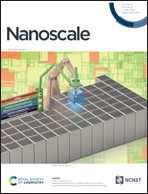From metal nanowires to ultrathin crystalline ALD nanotubes: process development and mechanism revealed by in situ TEM heating experiments†
Abstract
The creation of hollow nanomaterials based on metal oxides has become an important research topic, as they show potential in a broad range of technical applications. However, the controlled synthesis of long and at the same time thin nanotubes is still challenging. Here we present a universal approach to create ultrathin aluminum oxide nanotubes with a length/diameter ratio of >1200 and minimum wall thickness of ≤4 nm. We use a facile process based on defined heat treatment of specific core–shell nanowires. The metal nanowires act as a template, which is thermally removed during heat treatment until an empty tube is created. The core–shell nanowires are produced by Physical Vapour Deposition (PVD) with a subsequent coating via Atomic Layer Deposition (ALD). The custom-built PVD–ALD system enables a direct sample transfer without breaking the vacuum, which allows determining the effect of a native oxide layer on the metal–ALD bonding. In combination with correlative ex situ observations, in situ Transmission Electron Microscopy (TEM) heating experiments unravel the dynamical processes going on at small scales. Based on the microscopic analysis, the energetics of the core material is analyzed, giving insights about heat induced effects as well as the phase transition from the amorphous to the crystalline state.



 Please wait while we load your content...
Please wait while we load your content...